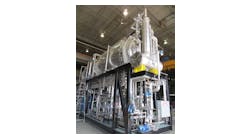Favorable temperatures (80-110°F) and availability of nutrients make cooling tower systems ideal places for microbial growth. Accumulation of biofilm impedes proper heat transfer and secretes metabolic products that contribute to microbiologically influenced corrosion (MIC). The films also may propagate and release disease-causing bacteria. Control of microbial growth is traditionally achieved with biocide combinations such as bleach, sodium bromide, stabilized bromines and various non-oxidizers. Major drawbacks are costs, safety and regulatory issues associated with bulk storage and use of these chemicals. While most such biocides achieve control provided they’re dosed appropriately and monitored by competent personnel, they constitute 30-70% of the chemical expense for a cooling tower system. As a result chronic underdosing to reduce costs is common. The biocides are highly corrosive and typically fed under pressurized lines that may burst or leak.
On-site generation of mixed oxidant solutions (MOS) from sodium chloride (salt) provides an attractive solution to concentrated biocides. Mixed oxidants are generated at the site by passing a 3-4% solution of salt through an electrolytic cell. The brine solution is converted to a powerful 0.45-0.9 % oxidant at pH 9.0 consisting of sodium hypochlorite (bleach) and minor components of other oxidants. This article documents a three-year study evaluating the cost and performance of MOS in cooling tower environments.
Study results
A district cooling tower system for a large central utility plant that cools many buildings in downtown Chicago was chosen for the initial site with the following baseline information:
- - Corrosion rates were 0.8-1.2 mil per year (mpy) for mild steel and <0.1 mpy for copper
- - Sodium hypochlorite was fed two times a week (8 gallons per slug)
- Isothiazolin was fed twice a week (6 gallons per slug)
- - Bacterial counts in the bulk water averaged 10,000 cfu/ml
- - Surface bacterial water counts averaged 100,000-500,000 cfu/ml.




